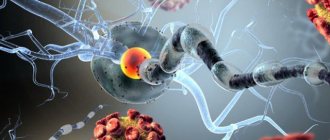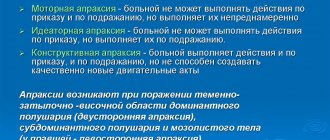From time to time, every person may notice that the brain is not functioning fully. Such a disorder is expressed in difficulty performing movements (bradykinesia) and in remembering information, inhibition of reactions and thinking disorders (bradypsychia).
It should be said that in most situations these failures are temporary and can be explained by natural factors: fatigue or nervous exhaustion. However, there are cases when the awkwardness of movements, inhibition of thinking and the mental sphere is a pathological process, the causes of which must be promptly identified and appropriate therapy selected.
Features of bradypsychia
Pathological inhibition of thinking is called bradypsychia. This phenomenon has no parallels with apathy or inertia of thinking, but suggests mental and pathophysiological disorders.
Bradypsychia is considered as a kind of neurological symptomatology, which in most cases develops in people in old age. But sometimes people at a young age, as well as children, experience inhibition in their thinking processes.
Poverty and insufficiency of mental processes is a symptom of many psychological or physiological pathological processes, manifested as a decrease in reaction speed, slow speech, slow thinking and motor activity. In difficult situations, the individual is not able to react to what is happening and remains for a long time in an apathetic state or stupor. The following types of inhibition are distinguished:
- complex;
- ideational;
- motor.
Thought processing can be impaired at any age
Retardation also occurs in speech and thought, which has psychological factors. Weak and involuntary movements can cause motor retardation. Memory problems and failures appear. In many cases, such conditions are provoked by a neurological disease, constant fatigue, or psychological pathological processes.
Slowness of movements and emotional inhibition is a pathological process, the causes of which only specialists can detect. They also recommend proper therapy.
Associated disorders
Bradypsychia is the result of damage to the central nervous system, which is responsible for brain activity. Depending on the element of the lesion, different types of disorders develop. These include:
- bradybasia - slow walking;
Bradykinesia is characteristic of parkinsonism - bradythymia - slow changes in emotions;
- bradykinesia - slow pace and limited range of movements;
- bradypraxia - slow direction of action;
- Bradylexia – slow reading;
- bradyphasia, bradyllalia is a slowdown in speech, at the same time it is almost always correct, observed both in adulthood and in childhood (bradylalia is often observed in patients recovering);
- Impaired articulation may also develop, and during a long conversation the person may become tired.
When bradypsychia is a consequence of Parkinson's disease, it is necessary to focus on the symptoms of the underlying pathological process. These include feelings of fatigue, anxiety, sleep disorders, etc.
Development of depression
Further, all manifestations worsen: attacks of melancholy become more frequent and lengthened, physical retardation becomes more pronounced, desire decreases until libido fades. Speech becomes impoverished, becomes monosyllabic, “dull,” and slow. Professional skills are partially lost.
Women have a tendency to self-blame. They consider themselves incapable of professional activity, unsuitable for family relationships, and incompetent in terms of raising a child. During this period, daily mood swings are common, with patients feeling worse in the morning than in the evening.
Provoking factors and diseases
The pathophysiology is very complex and not fully understood. It is only known that thinking, behavior, emotional component and other functions of the human brain are associated with the activity of the limbic system. In everyday practice, only conditions are identified - diseases, during which bradypsychia and accompanying deviations are observed:
- Vascular diseases of the brain.
Acute, often chronic disorders of blood flow in the brain, which arise due to progressive atherosclerosis, hypertension, embolism and vascular thrombosis, are a factor in the destruction of substances in the brain. The structures that are responsible for quick thinking are also susceptible to disruption. - Parkinson's disease
. A common cause, the characteristic manifestation of which is slow thinking. In addition to such depressing symptoms (patients at a late stage of development of this pathological process do not tend to notice any changes), there are a large number of other unpleasant manifestations. For example, thoughts will become not only slow, but also viscous; the patient will be characterized by importunity and slow, confused speech. - Epilepsy
. At a late stage in the development of the disease, when experts observe the destruction of personality as a result of a progressive disease, inhibition may be noted, as well as other symptoms of altered thinking. - Schizophrenia
. As with epilepsy in schizophrenia, bradypsychia is not considered an initial symptom of pathological processes, but develops gradually over time. - Depression
. A mental illness that is characterized by a large number of symptoms, often disguised as somatic difficulties - including toothache or ischemia. These also include sluggish thinking. - Hypothyroidism
. Improper functioning of the thyroid gland. With this disease, the symptoms are extremely pronounced and are one of the first to occur. - Toxic lesions
. Such a subgroup of diseases does not exist in the international classification. However, the term best describes the causes of painful symptoms - intoxication of the body.
The short-term effect of lethargy appears after lack of sleep, due to exhaustion of the body, or as a result of the use of drugs and alcohol that inhibit thinking and movement. The reasons can be divided into those that block brain activity and those that reduce the possibilities for its implementation.
Naturally, with such an abundance of provoking diseases, treatment can also be different.
Worsening of the condition
Without appropriate treatment, depression becomes even more severe. Melancholy becomes unbearable and is often combined with anxiety and lack of feelings. Deterioration in memory, perception, and ability to think clearly becomes obvious. The person realizes the loss of his abilities and sharply regrets them. There may be an exaggeration of once-committed offenses.
The appearance changes - the condition of the skin worsens, its turgor decreases, it becomes pale, sometimes even blue, and flakes off. Nails break, hair becomes dull. Patients stop taking care of themselves. Women often experience disruptions to their monthly cycle, leading to the onset of amenorrhea. Somatic symptoms include tinnitus, pain, heaviness in the head, and a feeling of coldness in the extremities.
What does it look like?
The image of a “inhibited” patient falls under the typical characteristics of a melancholic person: weakness, slowness, drawn-out speech, every word is pronounced with effort.
There may be a feeling that the thought process takes a large amount of strength and energy from a person who does not have time to react to information or is completely plunged into a stupor.
In addition to a decrease in the speed of speech and thought processes, muffled words are observed - a very quiet and calm voice, sometimes breaking the silence. Weakness is visible in movement and facial expressions; posture is often too relaxed.
A person has a desire to constantly find support or lie down.
Not all symptoms are always observed. Just one thing is enough to recommend a person to seek medical help from specialists.
Treatment
Therapy for this pathology is carried out using conservative treatment and radical measures.
Radical surgery includes surgical intervention if such a patient is diagnosed with a tumor of the brain or nervous system. During treatment, removal is carried out, followed by the prescription of medications and specialized rehabilitation.
The following medications may be prescribed:
- painkillers;
- sedatives;
- antibiotics in the treatment of an infectious disease;
- nootropic;
- antidepressants;
- tranquilizers;
- means for restoring glucose levels;
- complex of vitamins and minerals (selected individually).
Best materials of the month
- Coronaviruses: SARS-CoV-2 (COVID-19)
- Antibiotics for the prevention and treatment of COVID-19: how effective are they?
- The most common "office" diseases
- Does vodka kill coronavirus?
- How to stay alive on our roads?
Psychotherapy is carried out as an addition to drug treatment. Modern methods of such therapy will help to establish the true cause of inhibition. The doctor forms new behavior for the patient during stressful situations, and also corrects the personal assessment.
Self-medication is strictly prohibited, so as not to aggravate an already difficult situation. Before visiting a psychotherapist, preventive measures can be taken. All drug prescriptions and dosages should be performed only by a qualified specialist. Therefore, you should definitely consult a doctor for medical help.
If the patient fully follows all the doctor’s recommendations and prescriptions, provided that the treatment was started in a timely manner and correctly selected, then his full recovery is possible.
At high temperatures, it is necessary to take medications to lower it. If the phenomenon appears after taking potent sedatives, then it must be stopped by stopping their use. In this case, the inhibition will go away without a trace and all reactions will be restored.
Diagnostic criteria and methods
People with speech rate disorders, including bradyllalia, need comprehensive medical, psychological and pedagogical diagnostics carried out by a specialized specialist. During the examination, the patient’s medical history should be studied in detail, which concerns previous illnesses and brain lesions, as well as the presence of disturbances in the rate of speech in relatives.
In certain situations, in order to find out the organic basis of the disease, it is necessary to conduct instrumental studies, including:
- electroencephalography;
- rheoencephalography;
- Magnetic resonance imaging;
- PET scan of the brain;
- Lumbar puncture.
The study of oral speech involves assessing the structure of the organs of articulation and the state of motor skills, expressive speech (pronunciation of sounds, syllables, words, tempo-rhythmic side, voice characteristics, etc.). Diagnostics of written speech involves performing tasks such as copying text, writing from dictation, and reading. In addition to a diagnostic examination of speech function, a study of general condition, manual motor skills, sensory functions, and intelligence is carried out.
When making a diagnosis, it is necessary to differentiate this disease from dysarthria and stuttering.
What does modern medicine offer?
To carry out proper treatment of the disease, you must first consult with a specialist. He will recommend effective treatment, and will also warn about the presence of contraindications to the use of certain therapy methods or any medication.
The following methods of therapeutic and preventive action are used more often than others:
- Activation of thinking processes
. For these purposes, you need to read new books, study foreign languages, engage in the creative process, or solve various puzzles. This technique helps train the brain and activate thinking. - Neuroprotectors and nootropics are prescribed
. Drug therapy that is aimed at restoring and strengthening nerve cells and tissues. - Treatment of vascular pathologies
. Products are used that make it possible to cleanse the vascular walls, which is necessary for proper brain function. As a result, mental and physical activity is activated. - Psychotherapy
. It acts as an auxiliary drug therapy. Modern therapeutic techniques help counteract the effects of stress, adjust personality assessment, and form the necessary models of response to specific situations. - Sports activities and walks in the fresh air
. Moderate physical stress and walks give the brain the opportunity to rest and the nerve cells to recover thanks to the influx of oxygen.
If emotional and mental retardation is caused by tranquilizers, then discontinuation of any drugs is required. In most cases, reactions recover over time.
Summing up
The prognosis is relatively favorable with an early start of correction and the presence of psychological causes of disorders of motor activity and speech motor skills. However, after regaining your skills, you should be observed by doctors for a long time and constantly independently monitor your movements and train of thoughts.
As preventive measures, damage to the central nervous system should be prevented, head injuries should be avoided, and asthenic syndrome should be detected in time.
Pathological inhibition of thinking involves various mental and pathophysiological disorders. This phenomenon should be qualified as a symptom that in most situations occurs in older people. But in certain cases, a similar problem can manifest itself in childhood and young people.
If you notice that your thinking processes are slow, you should immediately seek advice from a doctor. It is likely that this condition is the result of dangerous disruptions in the functioning of the central nervous system and requires special correction.
Diagnostics
Lethargy, fatigue, and weakness are common reasons for people turning to a neurologist. Less often, the initial examination is carried out by a therapist or psychiatrist. First, a clinical interview of the patient, observation and examination is carried out. In order to objectively confirm the presence of inhibition, a pathopsychological examination and psychophysiological tests are performed to determine the reaction rate. To clarify the diagnosis, instrumental studies of the brain and its vessels and blood tests for hormone levels may be prescribed. The standard diagnostic complex includes:
- Clinical conversation.
When interviewed, patients complain of slowness, memory impairment, and decreased intellectual abilities. They say that they have become worse able to cope with professional responsibilities and everyday affairs, and are unable to carry on a conversation. Possible additional symptoms are drowsiness, headaches, confusion. Children show moodiness, tearfulness for no particular reason, and lack of interest in games. - Observation.
When answering a doctor, patients often pause and drawl out their words. The voice is quiet, they speak unintelligibly, the question is answered after silence, so it may seem that auditory perception is impaired or it is difficult to understand the meaning of what was said. They are slow and passive in behavior. The movements are awkward and forced. - Study of thinking.
Pathopsychological tests are carried out to assess the speed of the thought process: an associative experiment, selection of antonym words, and others. The results indicate a slowdown in the pace of cognitive functions, a decrease in the number of ideas, and “getting stuck” on one thought. Intellectual activity is characterized by inertia and inactivity. - Determination of reaction rate.
When diagnosing retardation, psychophysiological methods are used that measure the reaction time to a stimulus (sound, light) and parallel changes in the bioelectrical activity of the brain, heart rate, and respiratory rate. With inhibition, a significant increase in the time of simple visual-motor and auditory-motor reactions, depression of the alpha rhythm on the EEG, and slowing of breathing are detected.







